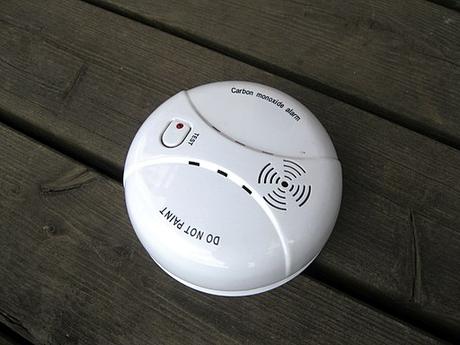Carbon monoxide is an odorless tasteless and very poisonous gas. The dangers lie in the fact it is tasteless and odorless. This gas is commonly associated as a by-product of the combustion of engines. In general, though, it is the result of the combustion of fossil fuel.
Why is carbon monoxide dangerous?
Carbon monoxide is very dangerous apart from the fact that this gas is hard to detect without using a carbon monoxide detector, according to CDC this gas is responsible for accidental poisoning in the United States with 430 deaths each year.
Once it goes through the lungs of a person, it holds on to the red blood cells and deprives the person’s body of oxygen. What makes it more troubling is that before the symptoms turn deadly, it exhibits normal flu or cold-like symptoms such as mild headaches, nausea or shortness of breath.

Some of the common symptoms of carbon monoxide poisoning are:
- nausea
- vomiting
- confusion
- dull headache
- dizziness
- weakness
- blurred vision
- loss of consciousness
- shortness of breath
How does a carbon monoxide detector work
In a nutshell, the carbon monoxide detector works by sensing the presence of the compound in the air. As it is odorless, it cannot be detected by the human olfactory system. The carbon monoxide alarm goes off if it detects a predetermined percentage of carbon monoxide in the air for a certain period. Take note that different brands have a different system or beep codes thus it pays that homeowners read the manual that comes with the device.
As for the real sensors, it comes in three variants.
A metal-oxide-semiconductor is an electronic component that lowers the electrical resistance when it senses high CO2 concentration in the air.
Another type is the biomimetic sensor. This comes in a gel that changes color as it absorbs carbon monoxide. This change triggers the alarm.
Then there’s the electrochemical sensor. This one has electrodes immersed in a chemical solution that are sensitive to the presence of carbon monoxide. This changes the electrical current in the system. This triggers the alarm when the threshold is reached. Generally, it should be below 50ppm as beyond that can result in nausea and loss of consciousness which is already fatal.
Carbon Monoxide Detector Beeping
If your detector is beeping, it can mean an error. One common error for this beeping sound is the low battery. This is in the form of a short chirp. Owners should be able to differentiate this from the actual alarm. Carbon monoxide warning usually beeps 3 to 4 times. This happens with 4-second intervals in between. In a nutshell, the beep should annoying enough that you will easily take notice of it.

The problem here is that most homeowners do not read the manual thus they panic when a chirp goes off. Being informed should set peace of mind to your home.
Why do you need a carbon monoxide detector
Some people do not appreciate having a carbon monoxide detector at home. Many will just shrug thinking this is just another device for vanity. But in reality, this is for home security and family safety. The usual setting for carbon monoxide poisoning is when windows are closed in a building. And this is a common setting during winter.
And people spend more time at home during winter making matters worse. Plus the fact that this is the season that heaters are used for long hours. These things pile up the chances of pooling of carbon monoxide in the air. Also, car idling before leaving home becomes a norm in winter. This is to get to operating temperatures, therefore, avoiding engine problems while on the road. But these activities put in more carbon monoxide emissions inside homes. As it is odorless, you may never know if the concentration level goes beyond 50ppm.
And just with a fire alarm, you need to know if the danger level is reached. CO poisoning can cause damage to your brain and it can reach the point where it becomes irreversible. If you weigh your family’s safety more then having a CO detector at home is a must.
Where to put a carbon monoxide detector in your home
There are existing laws that govern this. The best way is to know what is required by the local law. Your location determines the minimum number of detectors that should be installed in your home. The basic is that it has to be set in locations that are close to the source of CO emissions and where most people stay for a long time.
Generally, you must have one at every level of your home. This is because each floor may differ in CO concentrations. Another is that you may be required to put sensors in every room like your garage, kitchen and living room. There’s a tendency for gas to be concentrated in one area then thins out in another. Placing several sensors around your house will give you redundancy in terms of safety. Also, the alarm must be heard by the occupants at such it has to be near the sleeping area.
The height of the sensor in about the floor must be taken into consideration. Sensors will have better chances of detecting CO concentration at around 5 feet high. The manufacturers have specific designs for their sensors and this must be followed for safety.
Best carbon monoxide detectors
There are dozens of choices for carbon monoxide detectors these days. There are battery-operated ones and the ones that need to be plugged in a socket. With the advent of the internet of things, some detectors have the capacity to inform you about the detection and warning through an app. But as more choices are made available, it also complicates your situation. To help you out here are some that deliver the right goods.
Nest Protect
This is among the top choice for modern homes these days. This device has a multicolored light ring that lights red when detecting carbon monoxide. To deliver enhanced protection, it connects to the Nest Thermostat that automatically disables the furnace if carbon monoxide is high. This gives ample time for evacuation in emergencies. It comes with a 10-year electrochemical carbon monoxide sensor using electrodes, the best in its class.
Kidde Nighthawk
This one comes from the world’s largest fire safety manufacturer. For that, it offers the best in what it does and some more. It has a digital display that informs you about your home’s carbon monoxide levels. As the device refreshes the data every 15 seconds, you’ll be better informed when something goes wrong. To get the information across, the device has an 85 dB beep which is comparable to an average cellphone ring in full volume. Unfortunately, this is not a fancy choice if you prefer to connect it with your home automation.
Arikon Smoke and CO Detector
This device is the best 2-in-1 system you can find. It uses photoelectric and electrochemical sensors to check on both smoke and carbon monoxide. Having 2 devices in one does not just save you money but space and installation as well. It saves you that hassle. It has an 85dB alarm which should be able to wake you up even in the middle of the night. It is battery-operated which means no wires needed plus it can be installed virtually anywhere. It’s not compatible with home automation but it is a good choice if you just need the basics covered.
Kidde KN-COPP-B-LPM
The key feature of this device is an easy installation. It is a battery-operated CO detector. It has an electrochemical sensor that is often regarded as the best way to detect CO concentration in your home. It has a digital display making it easy to monitor the presence of carbon monoxide. It comes with an 85 dB alarm which ensures you hear the danger ahead. No smart home capability in this device.
Conclusion
Although carbon monoxide poisoning poses a serious risk to your family and home, the good thing is you can prevent it from happening. Apart from installing a carbon monoxide detector throughout your home, you can try the following:
- Don’t warm up your car in the garage
- Ensure proper ventilation
- Do not use gas range to heat your home
Always consider the safety of your family and home by investing in the top-of-the-line home security systems to ensure quality products and services.
